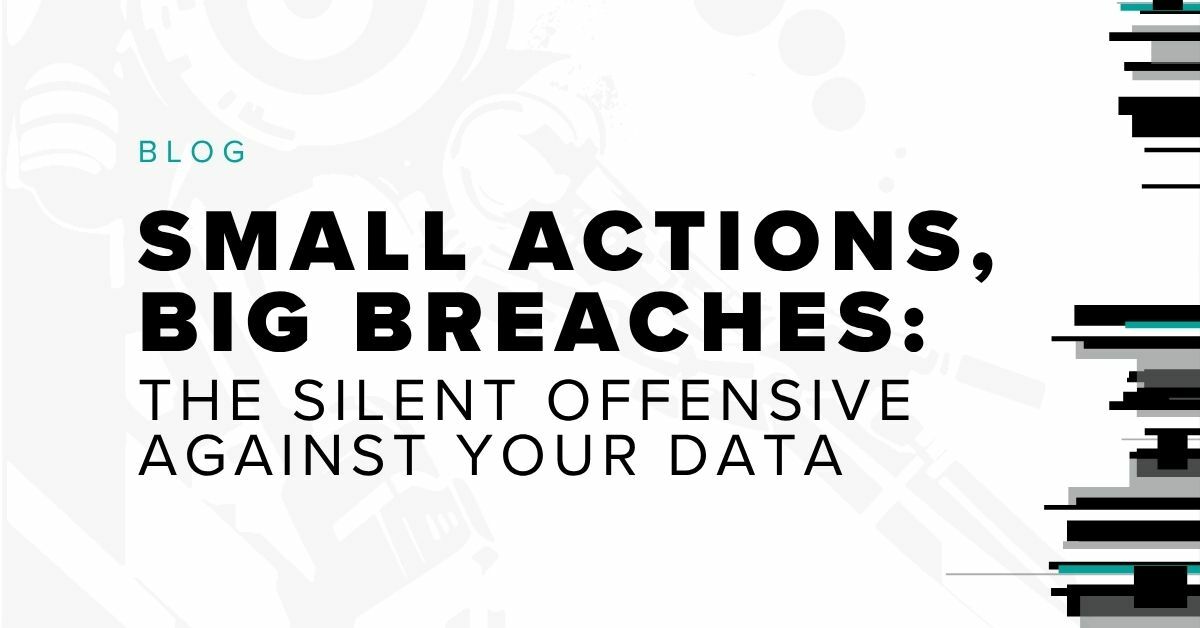Small Actions, Big Breaches: The Silent Offensive Against Your data

A new report, Enterprise AI and SaaS Data Security Report, landed this month, and its findings demand attention from security leaders. The report puts numbers behind a growing truth: user behavior has become one of the most consistent sources of data exposure inside the enterprise.
The analysis of enterprise browser activity revealed:
- 45% of employees use generative-AI tools
- 77% paste data into them
- 82% of those pastes come from personal, unmanaged accounts
- Nearly 40% of uploaded files contain sensitive data such as PII or PCI
Those numbers reinforce what the 2025 Verizon DBIR analysis has found for several years: most breaches (60%) involve the human element: error, misuse, or accidental exposure. They also mirror what our Bishop Fox penetration testers and Red Team specialists see in the field every week. Attackers don’t always need advanced exploits when human behavior can create faster, quieter paths to valuable data.
Seeing What Attackers See and Leading Beyond It
From an offensive perspective, the latest data reads like a map of opportunity. Every unmanaged browser session, personal SaaS login, and AI prompt is a potential opening through exploitation and observation. At enterprise scale, these small, routine actions create a steady stream of sensitive data leaving the organization, often unnoticed and unlogged.
Our offensive security teams see this firsthand. In controlled assessments, we’ve recovered customer records, credentials, and confidential documents from the same AI tools and SaaS platforms employees rely on every day.
The real issue isn’t just behavior. It’s the environment that allows it to persist, often defined by unclear policy, limited enforcement, legacy defenses, and leadership blind spots.
- Many AI and SaaS platforms operate outside corporate governance, leaving no boundaries for what employees can use.
- Where policies do exist, they’re often unenforced, so convenience wins over compliance.
- Traditional DLP and identity controls were designed for file uploads and static endpoints, not browser-based work and GenAI prompts.
- And without leadership alignment, these gaps remain disconnected symptoms rather than a unified risk.
Closing this gap is not just a technical project; it’s an organizational one. Security leaders must bring governance, visibility, and identity to where work actually occurs, i.e., browsers, SaaS, and AI platforms. The strongest programs already do. They treat human behavior not as a weakness to correct, but as a surface to understand, measure, and protect.
From Offense to Leadership: Six Moves That Matter
After seeing how these gaps form in real environments, the next step is translating that insight into action. These six moves show where to start and how to close the distance between user behavior and security control.
- Establish AI and SaaS ownership across the business.
Governance fails when no one owns it. Define who manages risk for third-party AI tools, SaaS platforms, and cloud services, from procurement through monitoring. Cross-functional ownership closes gaps between policy and practice. - Build visibility into everyday workflows.
Extend monitoring to where behavior occurs, in browsers and SaaS platforms. Capture telemetry on copy, paste, upload, and prompt activity to identify where sensitive data moves and why. - Turn governance into enforceable control.
- Policies only work when backed by technology:
- Restrict unapproved platforms through application allowlisting.
- Instrument browsers with telemetry and logging to detect sensitive copy, paste, or upload activity.
- Route approved AI traffic through enterprise-hosted or monitored instances to maintain visibility and control.
- Policies only work when backed by technology:
- Test workflows the way attackers do.
Simulate human-driven leaks in penetration testing or red team exercises. Model prompt leakage, SaaS misuse, and data drift across integrations. Testing workflows and systems exposes what static assessments miss. - Operationalize offensive insight.
Feed findings from penetration tests and red-team engagements directly into control design and policy review cycles. Offensive testing should help shape governance, not sit beside it. - Measure and communicate behavioral risk.
Track how often sensitive data interacts with unmanaged tools, how AI is used across teams, and how often policies prevent or detect exposure. Translating behavior into metrics makes risk visible and governance defensible.
Together, these moves create a framework for human-speed security. One that integrates governance, visibility, and offense into a living program that evolves as fast as the work it protects.
The Bigger Picture
AI and SaaS have changed how people work, but security models are struggling to keep pace. While most programs are focused on systems and configurations, new exposures are happening in behavior via copy, paste, and upload actions that define modern productivity.
Attackers already know this. They use the same tools employees do, watching where convenience eclipses control. Every unmanaged browser, personal SaaS account, and public AI model expands the perimeter faster than policy can catch it.
For leaders, the challenge isn’t building new defenses; it’s building awareness and accountability into the way work happens. Governance must move closer to the user and visibility must extend beyond endpoints to the actions that matter most. The organizations that act on that won’t just reduce risk. They’ll define what effective security looks like in an era where human speed drives both innovation and exposure.
Subscribe to our blog
Be first to learn about latest tools, advisories, and findings.
Thank You! You have been subscribed.



